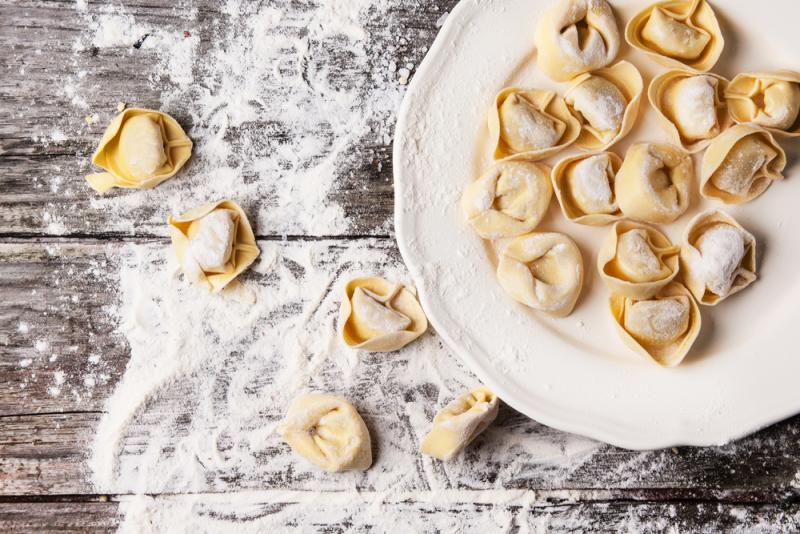The southern Italian region of Campania boasts a rich culinary tradition: the range of dishes and recipes made here contribute to the gastronomic prestige of an area known as the ‘cradle of pasta’.
There are indeed many places in Campania that are synonymous with pasta production; a visit to the area will allow you to discover the origins and traditions of a product that is a world-famous symbol of the Made in Italy brand.
And it is right here, in the heart of pasta production land, precisely in the village of Caggiano, that local pasta producer J-Momo keeps its pasta-making labs, where pasta is hand-made following traditional techniques.
A visit to Caggiano combines history, art and culinary traditions, that is, the best of Italy.
Caggiano

This village of approximately 1700 residents is located on a mountain in the Lucano Apennines, at the border with the National Park of Cilento and the Vallo di Diano. The historic town center features examples of the village’s thousand-year-old history everywhere, with the walls representing the most striking evidence.
Lucani, Romans, Lombards, Normans, Angevins, Byzantine monks and Templar knights all have left their mark. It’s easy to be transported back in time as you walk the streets of a village whose origins date back to between the 8th and 7th century BC, made all the more fascinating by its location on a rocky ridge, among rolling hills, olive groves, verdant valleys and rugged peaks.
The houses of the old town are guarded by large stone doors, at times embellished with friezes, ancient coats of arms and door-knockers, rather than modern-day bells. Most of these houses date back to medieval times, contributing to the village’s irresistible charm.
What to see in Caggiano

The village stands on a hill which affords a beautiful view of the Alburni Mountains; on a rocky spur are the ruins of the Oratory of Santa Veneranda, which for three years has been included in the list of FAI’s beloved places (‘luoghi del cuore’); built in the 16th century to honor the patron saint of Caggiano, the oratory offers views as far as the Gulf of Salerno on the clearest days.
Caggiano is also famous for its churches and several works of art: among them are the Church of Santa Maria dei Greci, dating back to the mid-6th century; the Church of Santa Caterina Vergine e Martire; the Mother Church of the Santissimo Salvatore.
The 15th-century Convent of Reformed Fathers (Convento dei Padri Riformati) houses the Civic Antiquarium Museum with several works of art on display.
The Castle of Caggiano
A must-see during a visit of Caggiano is the Castle. It was erected between the 10th and 11th centuries by Guglielmo di Caggiano, a member of the family of the Norman warlord Roberto il Guiscardo; some say the castle dates back to even earlier times.
The Castle was built as a defense outpost against enemy attacks, especially against the Saracens. Holy Roman Emperor Charles V tried to conquer it, to no avail: the city walls and overhangs surrounding the castle made it impossible to take.
According to legend, the Castle offered a resting place for many Templar Knights who came down from northern Italy during the Crusades, before embarking from the nearby port of Brindisi to reach the Holy Land. There are still several traces of their presence in Caggiano, especially in the form of esoteric symbols attributed to these ancient warrior monks. In the Contrada Sant'Agata, by the ruins of a church, the remains and armor said to belong to a Templar Knight were found; here, a street that runs through the contrada has been dubbed, ‘Via dei Templari’, the Street of the Templar Knights.

Cuisine and Tradition in Caggiano
Caggiano’s rich culinary heritage comes alive in the many typical products and dishes made here. J-Momo carries on the gastronomic traditions that have been passed down for centuries, using the same artisanal techniques.
Caggiano is home to J-Momo’s artisanal lab where fresh handmade pasta, fresh frozen pasta and frozen, ready-to-eat meals are lovingly produced. Many of the ingredients are sourced from local producers, starting with local pure water, to the ricotta cheese used for pasta fillings which is delivered warm to the lab every morning. J-Momo has purposefully maintained a close working relationship with local producers in order to guarantee quality and tradition and dish out those same flavors that have made this region famous all over the world.
Handmade fresh pasta by J-Momo

J-Momo’s mission is to combine tradition with innovation. Pasta is handmade with passion and the greatest care, using the same techniques passed down from one generation to the next by the first ‘pasta masters’ (mastri pastai). The result can be seen in the final products, which include fresh and dry pasta of the highest quality.
During production, only high-quality flour and semolina from selected Campania and Puglia producers are used; this guarantees that the pasta is at the same time tasty and easy to digest.
What makes J-Momo’s pasta special is the skillful touch of the pasta masters, which can never be replaced by a machine; and the care each J-Momo worker puts in the production process, from ingredients selection to kneading, to an attentive supervision of the entire productive cycle.
How to get to Caggiano
Caggiano is in the province of Salerno. Below are different option to reach Caggiano.
From Autostrada A3 Salerno-Reggio Calabria: take the Sicignano degli Alburni exit if traveling toward Reggio Calabria; or the Polla exit if traveling toward Salerno. Once you get off the highway, take SP 19 and follow directions for Caggiano.
If you’re coming from SS407 Basentana, take the Buccino exit and continue on SP19 following directions for Caggiano.
If you’re coming from the Val d’Agri, drive to Brienza, continue to Atena Lucana, then get on Autostrada A3 Reggio Calabria, exit at Polla and continue on SP19.
For more information about J-Momo pasta, click here.












